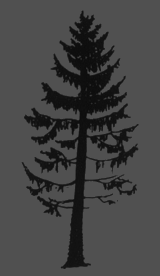About Wood|Species

Fir
Pseudostuga menziesii, Douglas Fir
Members of the pine family, Pseudotsuga (meaning “false hemlock”) is a small genus of approximately five species distributed through eastern Asia and western North America. These are not true Firs, not being of the genus Abies, but shares many common features with Hemlocks and has been grouped with them in common usage. These evergreen coniferous trees are distinguished from other species of pine by their distinctive cones, which have prominent tridents bracts poking between the scales. The common name honors the Scottish botanist David Douglas, who first introduced the species into cultivation in 1827, and is also known for introducing many North American native conifers to Europe.
The taxonomy of the Asian Douglas-Firs continues to be disputed, but most recent taxonomic accounts accept four species: three Chinese and one Japanese. They are species of a restricted range and little-known outside of their respective native environments, where they are often rare and of scattered occurrence. Of the remaining species, the Douglas Fir native to North America is one of the most economically important timber species in the world and consists of two distinct geographic varieties, although some botanists have proposed a variety of pocketed subspecies throughout both ranges.
Coast Douglas Fir ranges from west-central British Columbia south to Central California west of the Cascades. Rocky Mountain Douglas Fir occurs in the mountains of its namesake in British Colombia and the inland mountains of the Pacific Northwest south into northern Mexico. Its range is continuous from western Wyoming and central Idaho northward; southward it is more scattered and restricted to mountain topography. Both varieties are found in a wide range of forest types, primarily in association with other conifers and some deciduous trees. Both also grow on a variety of soils, and will tolerate dry conditions, but prefer moist, well-aerated, deep, nutrient-rich soils.
Coast Douglas Fir prefers a moist, mild maritime climate and grows between sea level and about 5,000 ft (1,525 m) in the north, while further southward both lower and upper limits increase. It cannot tolerate temperatures below 14 F (-10 C) for more than a week, while the Rocky Mountain Douglas Fir occurs at low to middle elevations and is much more frost tolerant. Both are long-lived and may become the dominant species in a forest over time; however this tendency is more common for the Rocky Mountain variety. More shade-tolerant trees often replace the Coast Douglas Fir, or it is disturbed by fire or logging, after which it re-establishes itself in even-aged stands.
The Douglas Fir is a medium to large tree depending on variety and environmental conditions with a shallow and wide-spreading root system. The Coastal Fir grows about 250 ft. (76 m), while the Rocky Mountain type reaches about half that at 120 ft. (36 m). In the open, young trees often retain their branches close to the ground, while in forested settings the lower limbs are gradually shed to create a straight massive trunk and a high, relatively narrow, pyramidal crown. Needles are yellow-green, to about 1 in. (2.5 cm) long, and set spirally around the branches. The mature, red-brown female cones are 2 to 4 in. (5 to 10 cm) long, and are primarily borne at the tips of higher branches hanging downward.
Extensively grown for reforestation, landscapes and as the Christmas tree, the Douglas Fir is the most utilized timber tree in North America. Particularly the coastal variety as their height makes them more desirable. The wood has a very straight grain with a creamy yellow early-wood and reddish brown late-wood lines, disparate in strength and hardness that give the wood an overall orange cast in colour.

 For best viewing experience please change your device orientation to landscape
For best viewing experience please change your device orientation to landscape